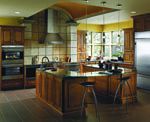
Here’s a well-equipped kitchen with state-of-the-art appliances
Green Kitchens are Here to Stay
The trend toward smaller homes seems to indicate a shift in American values, from a culture of consumption to a yearning for a simpler – and less expensive – way of life.
Yet, homeowners still expect some luxury and comfort – especially in their kitchens, which have emerged as gathering places for family and friends, says Tane Wilson, a Florida district sales manager at Westye Group.
Wilson spoke to a group of designers recently about housing market trends. She said two key trends – a green awakening and a desire for simplicity – are changing how people make decisions.
Wilson’s presentation focused on how to design a green kitchen, which is a common-sense choice because it can help create a more healthful home environment while conserving natural resources and lowering utility bills.
“People are accepting smaller homes, but they’re starting to have a better experience in those homes,” Wilson says. “They’re being frugal but they want luxury because they’re planning to stay in their homes longer.”
She says homeowners are looking for “user-friendly products, better technology and new appliances that are easier to cook with.” They want kitchens with multiple prep and cooking areas because couples are cooking alongside one another and even kids, who enjoy watching Food Network programming, are getting into the act.
In addition homeowners today, especially the younger generation, are more environmentally aware. So they’re opting for more natural and renewable materials, such as stone and bamboo flooring as well as recycled-content products for countertops and backsplashes.
Indoor air quality and energy efficiency are two of the most important considerations in designing a green kitchen space.
Ideally, an eco-friendly kitchen would offer plenty of fresh air and natural light. Stale air would be vented out of the house while artificial lighting and appliances would be energy-efficient.
INDOOR AIR QUALITY
The air in a typical home is full of pollutants, especially in the kitchen, where chemicals in cabinets, flooring, furnishings and paint “offgas,” and where smoke and cooking smells can escape into the rest of the house if ventilation is inadequate.
In a green kitchen, materials and equipment should be chosen for their health-positive or health-neutral qualities.
For example, ventilation and range exhaust systems with efficient and effective engineering design can quickly expel stale air from the home and bring in fresh, clean air, Wilson says.
A kitchen designed with an environmental focus will have a range exhaust system that’s properly configured and sized so it uses no more energy than needed and will remove pollutants generated at the range top in an efficient, healthy and quiet manner, Wilson says.
ENERGY EFFICIENCY
Consumers today are savvy about appliances; they want attractive, high-quality, user-friendly, Energy Star-rated products, Wilson says.
“Technology is changing and we’re having a different experience in the kitchen,” Wilson says, adding that the latest appliances are making it easier to prepare meals that are better tasting and more healthful – and don’t require the cook to spend all day in the kitchen.
The eco-friendly trend is having an impact on the growth of induction cooking, which is a quick, efficient method that uses a strong electromagnetic field to cause the pan to get hot instead of the cooktop. When the pan is removed, the cooktop becomes cool to the touch.
“I definitely think induction cooking is here to stay,” Wilson says. “It’s efficient and it’s kind of an aging-in-place technology. It’s safer for younger family members and older people.”
Steam ovens are big news too. “It’s huge because along with the culinary craze is the health craze,” Wilson says.
Even refrigerators are sporting better engineering design, with storage compartments that can help prolong the useful life of stored food. When a drawer is sealed, for example, it can decrease evaporative loss.
Filtered air can prolong the freshness and quality of food while filtered water can improve the taste and quality. That way, homeowners can rely less on bottled water – which saves money and means fewer plastic containers must be disposed of.
Here’s a well-equipped kitchen with state-of-the-art appliances, including a double-wall oven, a convection microwave with trim kit, a sealed-burner rangetop, a 36-inch Pro Wall chimney hood and a 30-inch warming drawer, all from Wolf. The refrigerators, including two under-counter models concealed in the island, are from Sub Zero.
A Wolf induction cooktop over a wall oven (above left) makes cooking easy and convenient while a 36-inch Sub Zero refrigerator over freezer (above) boasts a stainless steel finish and air and water purification systems.
